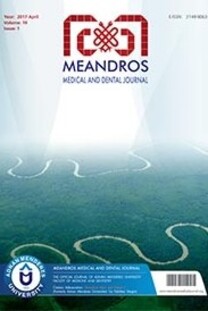Clinical and Ultrasonographic Evaluation of Masticatory Muscles in Young Subjects with and Without Bruxism
Bruksizmi Olan ve Olmayan Genç Bireylerde Çiğneme Kaslarının Klinik ve Ultrasonografik Olarak Değerlendirilmesi
___
1. Lobbezoo F, Ahlberg J, Raphael KG, Wetselaar P, Glaros AG, Kato T, et al. International consensus on the assessment of bruxism: Report of a work in progress. J Oral Rehabil 2018; 45: 837-44.2. Manfredini D, Lobbezoo F. Relationship between bruxism and temporomandibular disorders: a systematic review of literature from 1998 to 2008. Oral Surg Oral Med Oral Pathol Oral Radiol Endod 2010; 109: e26-50.
3. Camparis CM, Siqueira J. Sleep bruxism: clinical aspects and characteristics in patients with and without chronic orofacial pain. Oral Surg Oral Med Oral Pathol Oral Radiol Endod 2006; 101: 188-93.
4. Adisen MZ, Okkesim A, Misirlioglu M, Yilmaz S. Does sleep bruxism affect masticatory muscles volume and occlusal force distribution in young subjects? A preliminary study. Cranio 2019; 37: 278-84.
5. Palinkas M, Bataglion C, de Luca Canto G, Machado Camolezi N, Theodoro GT, et al. Impact of sleep bruxism on masseter and temporalis muscles and bite force. Cranio 2016 ;34: 309-15.
6. Goller Bulut D, Avci F, Özcan G. Ultrasonographic evaluation of jaw elevator muscles in young adults with bruxism and with and without attrition-type tooth wear: A pilot study. Cranio 2020; 38: 248-55.
7. Raadsheer MC, Kiliaridis S, Van Eijden TM, Van Ginkel FC, PrahlAndersen B. Masseter muscle thickness in growing individuals and its relation to facial morphology. Arch Oral Biol 1996; 41: 323-32.
8. Bakke M, Tuxen A, Vilmann P, Jensen BR, Vilmann A, Toft M. Ultrasound image of human masseter muscle related to bite force, electromyography, facial morphology, and occlusal factors. Scand J Dent Res 1992 100: 164-71.
9. Raadsheer MC, van Eijden TM, van Ginkel FC, Prahl-Andersen B. Contribution of jaw muscle size and craniofacial morphology to human bite force magnitude. J Dent Res 1999; 78: 31-42.
10. Karaman A , Kutalmış Buyuk S. Evaluation of temporomandibular disorder symptoms and oral health-related quality of life in adolescent orthodontic patients with different dental malocclusions. Cranio 2019: 1-9.
11. Cavallo P, Carpinelli L, Savarese G. Perceived stress and bruxism in university students. BMC Res Notes 2016; 9: 514.
12. Granada S, Hicks RA. Changes in self-reported incidence of nocturnal bruxism in college students: 1966-2002. Percept Mot Skills 2003; 97: 777-8.
13. Ayalı A, Ramoglu S. Assesment of prevalence and severity of temporomandibular disorders in North Cyprus dentistry students. J Dent Fac Atatürk Univ 2014; 24: 367-72.
14. Smardz J, Martynowicz H, Wojakowska A, Michalek-Zrabkowska M, Mazur G, Wieckiewicz M. Correlation between Sleep Bruxism, Stress, and Depression-A Polysomnographic Study. J Clin Med 2019; 8: 1344.
15. Bakke M, Tuxen A, Vilmann P, Jensen BR, Vilmann A, Toft M. Ultrasound image of human masseter muscle related to bite force, electro- myography, facial morphology, and occlusal factors. Scand J Dent Res 1992; 100: 164-71.
16. Chen YJ, Chang PH, Chang KV, Wu WT, Özçakar L. Ultrasound Guided Injection for Medial and Lateral Pterygoid Muscles: A Novel Treatment for Orofacial Pain. Med Ultrason 2018; 1: 115- 6.
17. Nomura K, Vitti M, Oliveira AS, Chaves TC, Semprini M, Siéssere S, et al. Use of the Fonseca’s questionnaire to assess the prevalence and severity of temporomandibular disorders in Brazilian dental undergraduates. Braz Dent J 2007; 18: 163-7.
18. Smardz J, Martynowicz H, Wojakowska A, Michalek-Zrabkowska M, Mazur G, Wieckiewicz M. Correlation between Sleep Bruxism, Stress, and Depression-A Polysomnographic Study. J Clin Med 2019; 8: 1344.
19. Ferreira-Bacci Ado V, Cardoso CL, Díaz-Serrano KV. Behavioral problems and emotional stress in children with bruxism. Braz Dent J 2012; 23: 246-51.
20. Serra-Negra JM, Paiva SM, Flores-Mendoza CE, Ramos-Jorge ML, Pordeus IA. Association among stress, personality traits, and sleep bruxism in children. Pediatr Dent 2012; 34: e30-4.
21. Nakata A, Takahashi M, Ikeda T, Hojou M, Araki S. Perceived psychosocial job stress and sleep bruxism among male and female workers. Community Dent Oral Epidemiol 2008; 36: 201-9.
22. Ohlmann B, Bömicke W, Habibi Y, Rammelsberg P, Schmitter M. Are there associations between sleep bruxism, chronic stress, and sleep quality? J Dent 2018; 74: 101-6.
23. Alóe F. Sleep Bruxism Treatment. Sleep Science 2009: 2; 4-52.
24. Emodi Perlman A, Lobbezoo F, Zar A, Friedman Rubin P, van Selms MK, Winocur E. Self-Reported bruxism and associated factors in Israeli adolescents. J Oral Rehabil 2016; 43: 443-50.
25. Huang GJ, LeResche L, Critchlow CW, Martin MD, Drangsholt MT. Risk factors for diagnostic subgroups of painful temporomandibular disorders (TMD). J Dent Res 2002; 81: 284-8.
26. Ahlberg K, Ahlberg J, Könönen M, Alakuijala A, Partinen M, Savolainen A. Perceived orofacial pain and its associations with reported bruxism and insomnia symptoms in media personnel with or without irregular shift work. Acta Odontol Scand 2005; 63: 213-7.
27. Kant P, Bhowate RR, Sharda N. Assessment of cross-sectional thickness and activity of masseter, anterior temporalis and orbicularis oris muscles in oral submucous fibrosis patients and healthy controls: an ultrasonography and electromyography study. Dentomaxillofac Radiol 2014; 43: 20130016.
28. Gibbs CH, Mahan PE, Mauderli A, Lundeen HC, Walsh EK. Limits of human bite strength. J Prosthet Dent 1986; 56: 226-9.
29. Mäntyvaara J, Sjöholm T, Kirjavainen T, Waltimo A, Iivonen M, Kemppainen P, et al. Altered control of submaximal bite force during bruxism in humans. Eur J Appl Physiol Occup Physiol 1999; 79: 325-30.
- ISSN: 2149-9063
- Yayın Aralığı: 4
- Başlangıç: 2000
- Yayıncı: Aydın Adnan Menderes Üniversitesi
Delal Dara KILINÇ, Emrah DİLAVER
Periodontitis Hastalarında Dinamik Tiyol/Disülfid HomeostazınınDeğerlendirilmesi
Meral GÜNHAN, Cemil NURAL, Mahmure Ayşe TAYMAN, Ceylan BAL
Şehrazat EVİRGEN, Fatih KARAASLAN, Ahu DİKİLİTAŞ
Hasan Onur ŞİMŞEK, Behiç Alp AYTEKİN
101 Top-cited Dentistry Articles From Turkey: A Bibliometric Analysis
Mustafa DEMİRCİ, Ferda KARABAY, Safa TUNCER, Meriç BERKMAN, Neslihan TEKÇE
Hakan EREN, Nilsun BAĞIŞ, Başak BIYIKOĞLU
Hümeyra TERCANLI ALKIŞ, Selin YEŞİLTEPE, Elif KURTULDU
Haematological Parameters in Children with Serum Folate Deficiency
Hatice Tuba AKBAYRAM, Mustafa ÖRKMEZ
Kalıtsal Nadir Faktör Eksiklikleri: Tek Merkez Deneyimi
Farklı İskelet Yapısına Sahip Bireylerde Faringeal Havayolu Hacminin Değerlendirilmesi
